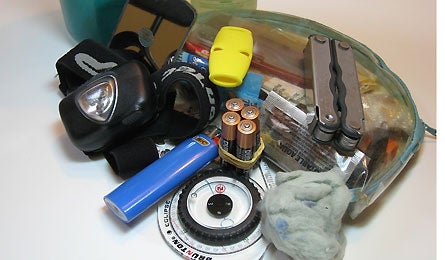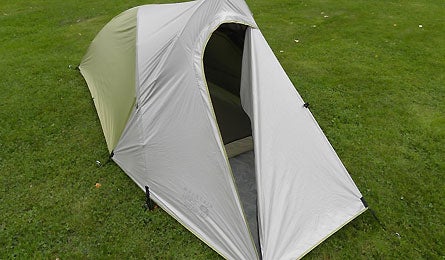Heading out the door? Read this article on the new Outside+ app available now on iOS devices for members! Download the app.

Don’t let retail seduction stretch the 10 essentials. (Jason Stevenson)

Shop smart so you can buy more of what you need (like this sweet tent). (JS)
Have you noticed the chill in the air? It means down jackets instead of rain shells and 15°F sleeping bags instead of 45°F. It also means watching your mailbox bulge with holiday catalogs tempting you to splurge on outdoor gear. Like a red-tailed hawk plummeting toward a napping cottontail, the glossy photos of shiny, new, tricked-out gizmos torpedo our defenses and make us covet extraneous gear we don’t need. Your plastic fork and spoon were perfectly fine until you spotted a shiny titanium spork for only $19.95. Before you know it, you’ve bought six of them!
Resisting the temptation to buy more gear, I realize, is like trying to stop a glacier from advancing. Plus, our beleaguered economy needs more consumer spending, not less. But here’s my anti-splurge argument: If you spend all of your funds on unnecessary gear, you won’t be able to buy the stuff you actually need. Every time you look at those five titanium sporks you never use, you’ll realize why you can’t afford a solo backpacking tent. So as the holiday retail onslaught builds, here’s my best defense: the 10 outdoor items you never should buy.
1. Hefty knifes/multi-tools
The size of your equipment matters, but in the opposite way than you first thought. When camping or backpacking, any tool that does the same job as another—but is smaller or lighter—is automatically better. Because of their “bigger is better” attitude, knives and multi-tools often add unnecessary ounces. Here’s a simple rule. If your knife could be menacingly brandished in a movie (think Crocodile Dundee), it’s too big. Likewise, if your multi-tool has more than one cutting blade, a metal file, or weighs more than five ounces, it’s better suited for your glove compartment than your backpack. Above all, if you’re looking for a tool for backpacking trips, try not to drop $1,400 on this “Mother of All” Swiss Army knives, which features 87 tools and weighs almost three pounds. Trust me, despite its indisputable coolness, it won’t fit in your pocket. (Now, for car-camping, that’s a different story.)
2. Nonbreathable rain pants
If the goal of foul-weather gear is to keep rain away from your body, then nonbreathable rain pants succeed. But if the goal is to keep you as dry as possible, then they fail. As Backpacker senior editor Shannon Davis puts it, “Your sweat will soak you as much as if you got rained on.” Hiking is a strenuous activity, and the heat produced by your churning legs will quickly rise to sauna-like temperatures if there’s no way—either via wide vents or a breathable membrane—for it to escape. So if rain pants are on your holiday shopping list, spend the extra $50 for the waterproof-breathable ones. If you’re still deciding, check out this Backpacker Forum discussion and these polls on the pros and cons of waterproof layers.
3. Snakebite kit
None of us can tell the difference between a rat snake and a gopher snake, but somehow we’ve all learned to cut an “X” over a snakebite before sucking out the venom. But first aid techniques gleaned from B-grade Westerns aren’t always accurate, or hygienic. Wilderness medicine experts now advise against the “cut and suck” technique to treat snakebites. Making incisions around a bite, they claim, damages skin and introduces infection. Plus, a study published in the Annals of Emergency Medicine demonstrated that the leading commercial suction device doesn’t work. According to the study, three minutes after eight human subjects were injected with radioactive fake venom (sign me up for that test!), the suction device removed less than 2 percent of the liquid from the affected tissue. For more effective snakebite treatments, consult Backpacker’s Medicine Man.
4. Torch lighter
I like fire as much as the next ex-Boy Scout. But I’m also practical. So a windproof torch lighter that generates a 2,000°F plasma flame sounds cool, as long as my buddy shells out the $50 to buy it. To light stoves, campfires, and the occasional bottle rocket, I prefer the generic Bic lighter, which costs about $0.50 at gas stations from Ohio to Kathmandu. Besides the 100-fold cost difference, here are three additional reasons to favor low-tech ignition sources. First, although a storm-proof torch light might work in hurricane conditions, most stoves or fires you’re trying to light aren’t going to. So unless you’re planning a dinner of crème brulée, a torch lighter will be a lonely spark in the storm. Second, Murphy’s Law dictates that small expensive gear is the first to get lost. Third, when flying, you can pack common lighters in your carry-on baggage, but torch lighters are still banned from all luggage. If a torch lighter is still on your holiday wish list, consider this alternative: The Soto Pocket Torch adapter transforms any rectangular lighter (i.e., not an oval-shaped BIC) into a jet-powered torch, and it won a 2010 Editor’s Choice Award.
5. Candle lantern
Abraham Lincoln learned to read and write by scratching the alphabet on hickory bark under the glow of a tallow candle. Impressive? Yes. But Abe was a whip-smart lad, and if Eli Whitney had invented the light-emitting diode (LED) instead of the cotton gin, I bet the Lincoln family would have been first adopters. Yes, candle lanterns are nostalgic, but LED headlamps and lanterns won’t make blind you or burn down your tent. My favorite lightweight camping lantern is the Black Diamond Orbit, which runs on four AA batteries and features a push-button dimmer. Disclosure: Black Diamond gave Prof. Hike one of these nifty lanterns for free.
6. Light My Fire Grandpa’s Fire Fork
The MIT-trained engineers at Light My Fire, Inc. probably spent several days locked in a dreary conference room refining their designs for this camping innovation. Formulas for thermodynamics, tensile strength, and heat transfer were tossed about before Dr. Jeff, the maverick of the group, remembered a home-spun wire contraption he saw in the 1957 Disney movie, Old Yeller. Or maybe he just had a creative grandfather. Either way, the result is Grandpa’s Fire Fork, a 0.6 ounce stainless steel marshmallow and hotdog roaster that’s “destined to become a modern classic.” Too bad, then, that prehistoric cavemen beat Light My Fire, Inc. to the marketplace with a renewable product with millions of years of positive reviews that can be fashioned by anyone, but especially three-year-old boys. It’s called a pointy stick. As for me, I prefer the stick.
7. Weather radio
The radios designed for outdoor enthusiasts don’t stop at AM/FM. The one I saw in a recent gear catalog was solar-powered, hand-crankable, and featured a built-in LED flashlight. I wondered if it was edible, too. So, if you’re a fan of apocalyptic zombie movies or Mayan calendar prophecies, you should purchase this radio for your underground bunker. You don’t want to miss your daily dose of Wait, Wait, Don’t Tell Me. But if you’d rather sleep in a tent than a fallout shelter, check the forecast at weather.gov before you leave for a hike, pack the proper equipment, and spend the $50 you saved on a foot massage.
8. Lensatic compass
Most hikers use a compass to answer basic navigation questions like “Which way is north?” “Which direction am I heading?” and “What is the bearing of that peak?” A lensatic compass can also answer the question: “What magnetic azimuth should I fire my artillery strike on the enemy encampment?” This device, also called an engineer’s compass, differs from a baseplate compass by having a flip-top lid, a sighting wire, and a pivoting lens. Plus, instead of a floating magnetic needle, the entire dial of a lensatic compass rotates. So if armored combat isn’t on your weekend itinerary, you can use a regular baseplate compass. It should be adequate for most navigation tasks like orienting a map, shooting a bearing, and triangulating your position. Just be sure to purchase a baseplate compass with an adjustable declination, especially if you don’t add or subtract well in your head.
9. Snowshoes
OK, before you winter-lovers stake me to the ground with icicles and dump powdery snow down my neck, just hear me out. I love snowshoes. I own a pair of snowshoes. But I’ve worn my snowshoes twice in the past five years, including a post-blizzard trek to the post office. Yes, I had great ambitions when I purchased my snowshoes back in 2003. Before buying them, I even rented a pair for a December hike in New Hampshire. But unless you live in northern New England, Alaska, or find powdery snow like a gray jay targets trail mix, your snowshoes probably will collect more dust than miles.
Yet every holiday season, outdoor retailers advertise snowshoeing as a winter alternative to running and biking. Since it’s too icy to run or bike, their catalogs imply, just strap on snowshoes to exercise in this evergreen-dotted winter wonderland. The reality is that snowshoes are tools like crampons and trekking poles, not exercise vehicles like running shoes and bikes. Only a precious few people actually snowshoe for exercise, and most of them live in Boulder, Colorado, and have a VO2 max close to Lance Armstrong’s. Remember, we dislike those people.
What’s more, the cost of a new pair of snowshoes is approximately the same as a new tent, sleeping bag, or backpack. And while you can bring any of those three items on most camping and backpacking trips, you can only justify snowshoes for a narrow range of winter conditions—at least eight inches of new, powdery snow. Nevertheless, snowshoes have become as specialized and technology-driven as athletic shoes. This winter you can buy a pair designed for a left-handed, 165-pound woman with double-jointed ankles. OK, that’s an exaggeration, but not by much. And while product diversification and innovation are generally positive steps, I’m not sure snowshoeing is the winter cure-all for everyone.
10. Mombasa Mosquito Net Body Suit
I’ve been to Mombasa, and I don’t recall anyone in the coastal Kenyan city wearing this ankle-to-head, polyester, no-see-um mesh body suit. In fact, if someone wore this outfit in Mombasa, they’d probably be mistaken for a giant meshy bug and quickly squashed. I don’t see how this bug suit could be 1) Practical, or 2) Comfortable. Of course, Minnesota and Maine residents should tell me if I’m off-base. This might be your state uniform from June to August.
Did this list stimulate your gear neurons? Respond, criticize, and suggest your own “don’t buy” items in the comments section below.
—Jason Stevenson